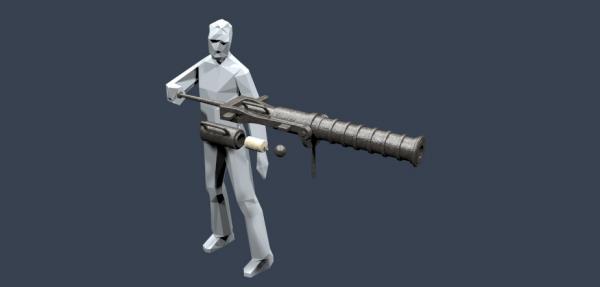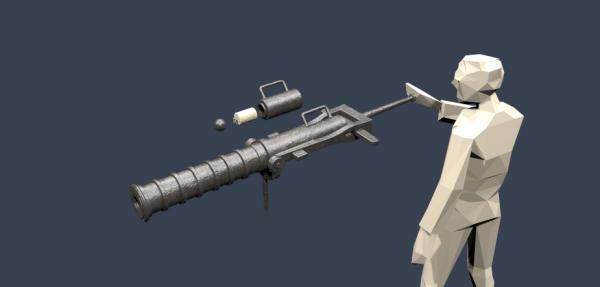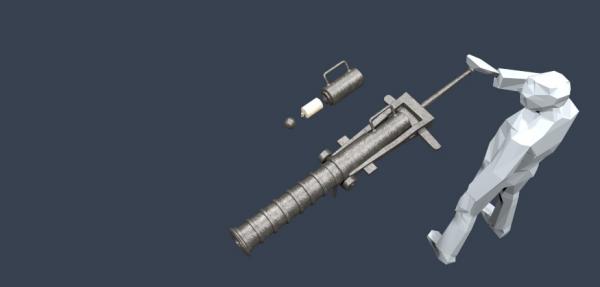
AndyHall
Members-
Posts
18 -
Joined
-
Last visited
Content Type
Profiles
Forums
Gallery
Events
Everything posted by AndyHall
-
Head figure for Royal yacht
AndyHall replied to igorcap's topic in CAD and 3D Modelling/Drafting Plans with Software
That is just beautiful. -
American Gunboat - 3d Design
AndyHall replied to Kalium's topic in CAD and 3D Modelling/Drafting Plans with Software
Beautiful! -
Swivel Gun from La Belle, 1684
AndyHall replied to AndyHall's topic in CAD and 3D Modelling/Drafting Plans with Software
Yes, they were certainly obsolete by La Salle's day. Similar (breech block, but not banded) guns were found in the 1554 Wrecks on Padre Island, but those are the only others I know of found in Texas. This (La Belle's) gun was found attached to its mounting post. It has a relatively large bore (3.42 inches, 9.3 cm, close to that of a four-pounder carriage gun. Although obsolete, it may have been seen as still useful against local Native Americans, who would have been relatively few in number and lacking firearms at all. -
Quick-and-dirty digital model of the swivel gun recovered from the wreck of La Belle (1684), excavated in Matagorda Bay, Texas, 1995-97. Based on a drawing by Donny L. Hamilton, found in "Modeling La Belle: A Reconstruction of a Seventeenth Century Light Frigate," Master's Thesis by Glenn P. Grieco, Texas A&M University, 2003.
-
U-576 Work-in-Progress
AndyHall replied to AndyHall's topic in CAD and 3D Modelling/Drafting Plans with Software
I do use Poser, but not in this case. For projects like this, I usually use a set of (very-low-res) ship's crew meshes bought from Turbosquid. I use them mainly to give an idea of scale. -
Reconstruction of an 18-pounder pivot gun employed aboard a small warship, 1820-40. Pivot and slide based on drawings by Howard Chapelle.
-
U-576 Work-in-Progress
AndyHall replied to AndyHall's topic in CAD and 3D Modelling/Drafting Plans with Software
Those are done with a bump map. I'm going to be redoing that, as well. -
U-576 Work-in-Progress
AndyHall replied to AndyHall's topic in CAD and 3D Modelling/Drafting Plans with Software
Rhinoceros for modeling, Flamingo for rendering. -
U-576 Work-in-Progress
AndyHall replied to AndyHall's topic in CAD and 3D Modelling/Drafting Plans with Software
Starting with a new hull. -
Keith, there are also internal views by Michael in the endpapers to Tom Chaffin's book on the submersible, which is a really good read anyways. Those other drawings were the basis for my cutaway views above,
- 7 replies
-
- Hunley
- H. L. Hunley
-
(and 5 more)
Tagged with:
-
Keith, I think you'll find what you need at Michael Crisafulli's website, The Vernian Era. Michael has done a good job of keeping up with the project and has a lot of his own analysis posted there. He even has a 1:24 scale drawing that you can download and print as a PDF. I believe Michael knows more about Hunley's design and construction than anyone not actually part of the team in the lab.
- 7 replies
-
- Hunley
- H. L. Hunley
-
(and 5 more)
Tagged with:
-
U-576 Work-in-Progress
AndyHall replied to AndyHall's topic in CAD and 3D Modelling/Drafting Plans with Software
These look very useful -- Dougie Martindale's guides to Type VIIC flood vent holes and colors: http://www.rokket.biz/modelsweb/rokket/u557/images/flood_patterns_dm.pdf http://www.rokket.biz/modelsweb/rokket/u557/images/uboat_colours.pdf From here: http://www.rokket.biz/modelsweb/rokket/u557/ubrass.shtml This is the boat with the two main colors replaced with two from Martindale's guide, Dunkelgrau 51 and Schiffsbodenfarb III Grau. I don't like it as much. Back to this: -
View of the interior of the Confederate submersible H. L. Hunley, as she appeared on her final mission in February 1864 near Charleston, South Carolina. Modeled in Rhino, based on plans by Michael Crisafulli and illustration concept by Dan Dowdey.
- 7 replies
-
- Hunley
- H. L. Hunley
-
(and 5 more)
Tagged with:
-
U-576 Work-in-Progress
AndyHall replied to AndyHall's topic in CAD and 3D Modelling/Drafting Plans with Software
The camo scheme is speculative, but it's similar to documented examples. The linked B&W photos of the actual boat suggest something like this. Still looking for a more complete reference that matches the images. Still have to add the weathering. -
C.S.S. Richmond was one of the earliest Confederate ironclads, having been laid down at the Gosport Navy Yard at Norfolk, Virginia, in March 1862, immediately after the completion of the famous C.S.S. Virginia (ex-Merrimack). Richmond was designed by John Luke Porter, who would go on to serve as the Chief Naval Constructor for the Confederacy, but completed under supervision of Chief Carpenter James Meads. Richmond embodied many of the basic design elements that be used, again and again, in other casemate ironclads built across the South in the following three years. When Union forces were on the verge of taking the Gosport Navy Yard, Richmond was hurriedly launched and towed up the James River, where she was completed at Richmond. Finally commissioned in July 1862, the ironclad served as a core element of the Confederate capital’s James River Squadron for the remainder of the war. Richmond, along with the other ironclads in the James, was destroyed to prevent her capture with the fall of her namesake city at the beginning of April 1865. This model is based on plans of the ironclad by David Meagher, published in John M. Coski’s book, Capital Navy: The Men, Ships and Operations of the James River Squadron, with modifications based on a profile of the ship by John W. Wallis, particularly regarding the position of the ship’s funnel and pilot house. Hull lines are adapted from William E. Geoghagen’s plans for a later Porter design for an ironclad at Wilmington, that seems to have had an identical midship cross-section.
- 4 replies
-
- Richmond
- Confederate Navy
-
(and 4 more)
Tagged with:
-
Work-in-progress render of U-576, a Type VIIC U-boat found recently off the coast of North Carolina. The base NURBS model is not mine, although I cannot now recall where I got it. I am in the process of detailing, modifying and retexturing. The camouflage is speculative, based on images of U-576 published by NOAA. The boat's emblem, on the front of the conning tower, would likely have been painted out when the boat was on patrol.
About us
Modelshipworld - Advancing Ship Modeling through Research
SSL Secured
Your security is important for us so this Website is SSL-Secured
NRG Mailing Address
Nautical Research Guild
237 South Lincoln Street
Westmont IL, 60559-1917
Model Ship World ® and the MSW logo are Registered Trademarks, and belong to the Nautical Research Guild (United States Patent and Trademark Office: No. 6,929,264 & No. 6,929,274, registered Dec. 20, 2022)
Helpful Links
About the NRG
If you enjoy building ship models that are historically accurate as well as beautiful, then The Nautical Research Guild (NRG) is just right for you.
The Guild is a non-profit educational organization whose mission is to “Advance Ship Modeling Through Research”. We provide support to our members in their efforts to raise the quality of their model ships.
The Nautical Research Guild has published our world-renowned quarterly magazine, The Nautical Research Journal, since 1955. The pages of the Journal are full of articles by accomplished ship modelers who show you how they create those exquisite details on their models, and by maritime historians who show you the correct details to build. The Journal is available in both print and digital editions. Go to the NRG web site (www.thenrg.org) to download a complimentary digital copy of the Journal. The NRG also publishes plan sets, books and compilations of back issues of the Journal and the former Ships in Scale and Model Ship Builder magazines.





